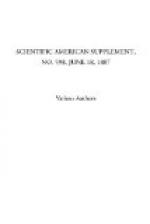between these two ports. By taking out her paddle
engines, she would be relieved of a weight of 850 tons.
The removal of her paddle engine boilers would further
lighten her, and would give in addition an enormous
stowage space. By using her both as a cargo and
a passenger ship, the whole of the upper portion could
be utilized for emigrants, let us say, and the lower
decks for cargo, of which she could carry nearly,
if not quite, 20,000 tons. She would possess the
great advantage that, notwithstanding she was a cargo
ship, she would be nearly, if not quite, as fast as
any, save a few of the most recent additions to the
Australian fleet. There is every reason to believe
that she has been driven at 14 knots by about 6,000
horse power. We are inclined to think that the
power has been overstated, and we have it on good authority
that she has more than once attained a speed of 15
knots. Let us assume, however, that her speed
is to be 13 knots, or about fifteen miles an hour.
Assuming the power required to vary as the cube of
the speed, if 6,000 horsepower gave 14 knots, then
about 4,800 would give 13 knots—say 5,000
horse power. Now, good compound engines of this
power ought not to burn more than 2 lb. per horse
per hour, or say 4.5 tons per hour, or 108 tons a
day. Allowing the trip to Australia to take forty
days, we have 4,320 tons of coal—say 5,000
tons for the trip. The Etruria burns about this
quantity in the run to New York and back. For
each ton of coal burned in the Great Eastern about
15,000 tons of cargo and 3,000 passengers could be
moved about 3-1/3 miles. There is, we need hardly
say, nothing afloat which can compare in economy of
fuel with this. Taken on another basis, we may
compare her with an ordinary cargo boat. In such
a vessel about 3,000 tons of grain can be moved at
9 knots an hour for 600 horse power—that
is 5 tons of cargo per horse power. Reducing
the speed of the Great Eastern to 9 knots and about
2,000 horse power, we have 9 tons of cargo moved at
9 knots per horse power; so that in the relation of
coal burned to cargo moved she would be nearly twice
as economical as any other vessel afloat.
The important question is, What would the necessary
alterations cost? Much, of course, would depend
on what was done. A very large part of the present
screw engines could be used. For example, the
crank shaft, some 2 feet in diameter, is a splendid
job, and no difficulty need be met with in working
in nearly the whole of the present framing. If
the engines were only to be compound, two of the existing
cylinders might be left where they are, two high-pressure
cylinders being substituted for the others. If
triple expansion were adopted, then new engines would
be wanted, but the present crank and screw shafts
would answer perfectly. The present screw would
have to be removed and one of smaller diameter and
less pitch put in its place. All things considered,
we believe that for about L75,000 the Great Eastern




